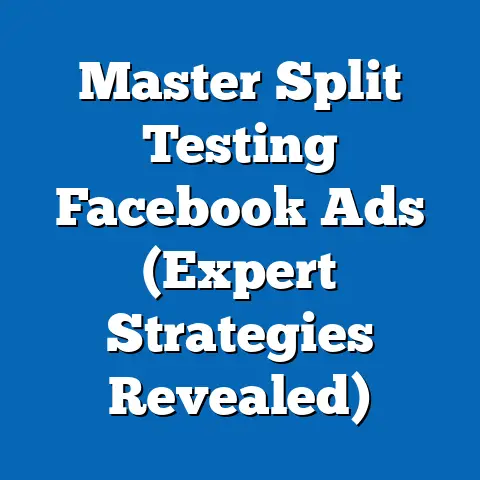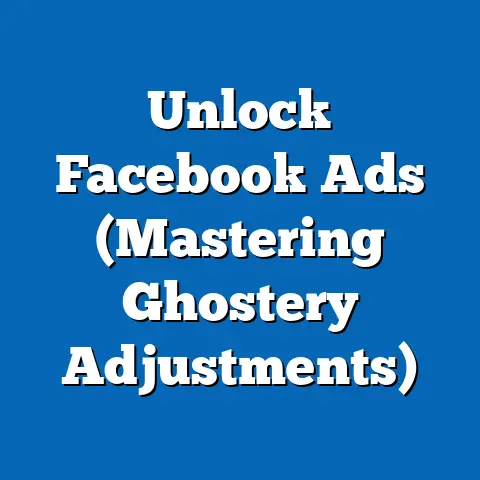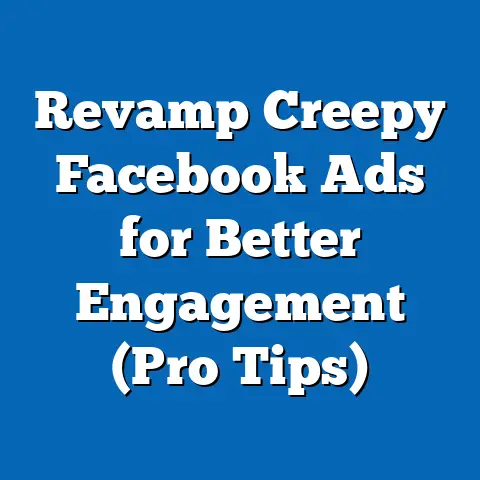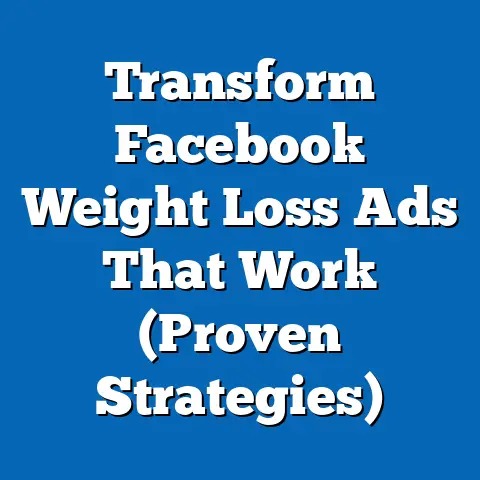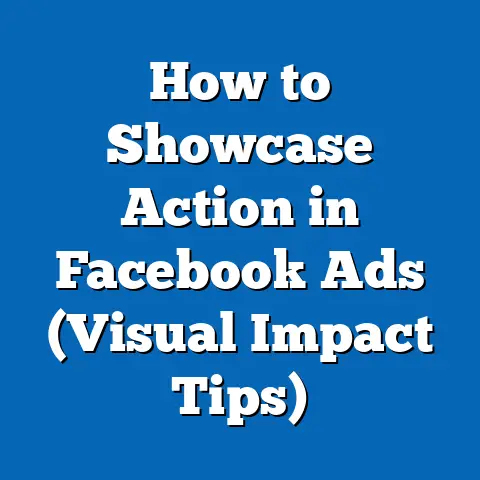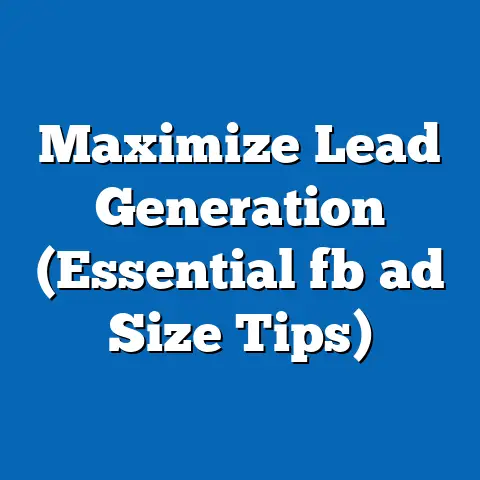Boost Sales with Facebook Ads Merch (Expert Strategies)
“I never knew how powerful Facebook Ads could be until I saw my sales double in just a month! The right targeting made all the difference.” – Sarah J., Small Business Owner. This quote perfectly encapsulates the potential of Facebook advertising for businesses looking to boost merchandise sales. I’ve seen firsthand how a well-crafted campaign can transform a small online store into a thriving brand. In this article, I’ll share expert strategies to help you unlock the power of Facebook Ads and drive serious revenue from your merchandise.
Understanding Facebook Ads
Facebook Ads are, at their core, paid messages that businesses can display on Facebook and Instagram. These ads are designed to reach a specific audience based on various factors like demographics, interests, behaviors, and more. What sets them apart from traditional advertising is their hyper-targeting capabilities and the ability to track performance in real-time.
In today’s digital marketing landscape, Facebook Ads are crucial for businesses aiming to increase brand awareness, drive traffic to their websites, and ultimately, boost sales. According to Statista, Facebook reaches over 2.9 billion monthly active users worldwide. That’s a massive audience, and Facebook’s sophisticated targeting tools allow you to pinpoint the exact customers who are most likely to purchase your merchandise.
Key Components of Facebook Ads
Understanding the different types of Facebook Ads and their objectives is essential for crafting effective campaigns. Here’s a breakdown:
-
Ad Types:
- Carousel Ads: These allow you to showcase multiple products or features within a single ad. I’ve found them particularly effective for displaying a range of merchandise.
- Single Image/Video Ads: These are straightforward and great for highlighting a specific product or promotion. High-quality visuals are key here.
- Slideshow Ads: These create a video-like experience using a series of images. They’re a cost-effective way to create engaging content.
- Collection Ads: Designed for mobile shopping, these ads allow users to browse and purchase products directly from the ad.
- Instant Experience Ads: These are full-screen ads that load instantly on mobile devices, offering an immersive experience for users.
-
Ad Objectives:
- Brand Awareness: Increase recognition of your brand among your target audience.
- Reach: Show your ad to the maximum number of people within your target audience.
- Traffic: Drive traffic to your website or landing page.
- Engagement: Encourage likes, comments, shares, and other interactions with your ad.
- Leads: Collect contact information from potential customers.
- App Installs: Drive downloads of your mobile app.
- Conversions: Encourage specific actions on your website, such as purchases, sign-ups, or form submissions.
Ad Types:
- Carousel Ads: These allow you to showcase multiple products or features within a single ad. I’ve found them particularly effective for displaying a range of merchandise.
- Single Image/Video Ads: These are straightforward and great for highlighting a specific product or promotion. High-quality visuals are key here.
- Slideshow Ads: These create a video-like experience using a series of images. They’re a cost-effective way to create engaging content.
- Collection Ads: Designed for mobile shopping, these ads allow users to browse and purchase products directly from the ad.
- Instant Experience Ads: These are full-screen ads that load instantly on mobile devices, offering an immersive experience for users.
Ad Objectives:
- Brand Awareness: Increase recognition of your brand among your target audience.
- Reach: Show your ad to the maximum number of people within your target audience.
- Traffic: Drive traffic to your website or landing page.
- Engagement: Encourage likes, comments, shares, and other interactions with your ad.
- Leads: Collect contact information from potential customers.
- App Installs: Drive downloads of your mobile app.
- Conversions: Encourage specific actions on your website, such as purchases, sign-ups, or form submissions.
Why Facebook is Perfect for Merchandise Sales
Facebook’s vast user base and precise targeting capabilities make it an ideal platform for businesses selling merchandise. Here’s why:
- Large Audience: With billions of active users, Facebook offers unparalleled reach.
- Detailed Targeting: You can target users based on demographics, interests, behaviors, and even their purchasing history.
- Affordable Advertising: Compared to traditional advertising methods, Facebook Ads can be incredibly cost-effective, especially when optimized correctly.
- Measurable Results: Facebook Ads Manager provides detailed analytics, allowing you to track your campaign performance and make data-driven decisions.
Takeaway: Facebook Ads offer a powerful way to connect with your target audience and drive sales for your merchandise. Understanding the different ad types and objectives is crucial for creating effective campaigns.
Setting Up Your Facebook Ads for Success
Before diving into creating ads, it’s essential to set up your Facebook Ads account and business page correctly. This foundation will ensure your campaigns run smoothly and effectively.
Step-by-Step Guide to Creating a Facebook Ads Account
-
Create a Facebook Business Page: If you don’t already have one, start by creating a Facebook Business Page for your brand. This page will serve as the identity for your ads.
-
Access Ads Manager: Go to Facebook Ads Manager (business.facebook.com) and log in with your Facebook account.
-
Create an Ad Account: If you don’t have an ad account yet, you’ll be prompted to create one. Follow the instructions to set up your ad account, including choosing your country, currency, and time zone.
-
Set Up Payment Information: Add your payment method (credit card or PayPal) to your ad account. This is necessary to run your ads.
Create a Facebook Business Page: If you don’t already have one, start by creating a Facebook Business Page for your brand. This page will serve as the identity for your ads.
Access Ads Manager: Go to Facebook Ads Manager (business.facebook.com) and log in with your Facebook account.
Create an Ad Account: If you don’t have an ad account yet, you’ll be prompted to create one. Follow the instructions to set up your ad account, including choosing your country, currency, and time zone.
Set Up Payment Information: Add your payment method (credit card or PayPal) to your ad account. This is necessary to run your ads.
Defining Your Target Audience
One of the most critical steps in setting up your Facebook Ads is defining your target audience. Facebook offers a powerful tool called Audience Insights that can help you understand your potential customers.
- Demographics: Target users based on age, gender, location, education, and more.
- Interests: Target users based on their interests, such as hobbies, favorite brands, and activities.
- Behaviors: Target users based on their online behavior, such as purchasing habits, device usage, and travel patterns.
- Custom Audiences: Upload a list of your existing customers (email addresses or phone numbers) to create a custom audience.
- Lookalike Audiences: Create a new audience that is similar to your existing customers or website visitors. I’ve found lookalike audiences to be incredibly effective for expanding reach while maintaining relevance.
Setting Your Budget
Setting a budget is crucial for managing your ad spend effectively. Facebook offers two main budget options:
- Daily Budget: Set a fixed amount you’re willing to spend each day.
- Lifetime Budget: Set a total amount you’re willing to spend over the entire duration of your campaign.
When choosing between daily and lifetime budgets, consider your campaign goals. Daily budgets are great for ongoing campaigns, while lifetime budgets are better for campaigns with a specific end date.
Takeaway: Setting up your Facebook Ads account correctly and defining your target audience are essential for launching successful campaigns. Use Audience Insights to understand your potential customers and set a budget that aligns with your goals.
Crafting Compelling Ad Content
Creating compelling ad content is crucial for capturing the attention of your target audience and driving conversions. Your ad copy and visuals need to work together to tell a story and persuade users to take action.
Elements of Effective Ad Copy
Your ad copy should be clear, concise, and persuasive. Here are some key elements to consider:
-
Headlines: Your headline is the first thing users will see, so it needs to be attention-grabbing. Use strong verbs, numbers, and keywords to make your headline stand out.
-
Descriptions: Your description should provide more detail about your product or offer. Highlight the benefits of your merchandise and address any potential objections.
-
Calls to Action (CTAs): Your CTA should tell users exactly what you want them to do. Use clear and direct language, such as “Shop Now,” “Learn More,” or “Get Started.”
Headlines: Your headline is the first thing users will see, so it needs to be attention-grabbing. Use strong verbs, numbers, and keywords to make your headline stand out.
Descriptions: Your description should provide more detail about your product or offer. Highlight the benefits of your merchandise and address any potential objections.
Calls to Action (CTAs): Your CTA should tell users exactly what you want them to do. Use clear and direct language, such as “Shop Now,” “Learn More,” or “Get Started.”
Creating Visually Appealing Ad Designs
Visuals are essential for capturing attention on Facebook. Use high-quality images and videos that showcase your merchandise in the best possible light.
- High-Quality Images: Use professional-grade images that are well-lit and visually appealing.
- Engaging Videos: Create short, engaging videos that demonstrate the features and benefits of your merchandise.
- Consistent Branding: Maintain a consistent brand identity across all your ads, including colors, fonts, and logos.
The Power of Storytelling
Storytelling is a powerful way to connect with potential customers on an emotional level. Share stories about your brand, your products, or your customers to create a deeper connection.
For example, if you’re selling handmade jewelry, you could share the story of how you started your business or the inspiration behind your designs. Or, you could share testimonials from satisfied customers who love your jewelry.
Takeaway: Crafting compelling ad content is essential for capturing attention and driving conversions. Use clear and persuasive ad copy, visually appealing designs, and storytelling to connect with your target audience on an emotional level.
Targeting the Right Audience
Targeting the right audience is crucial for ensuring your ads are seen by the people who are most likely to purchase your merchandise. Facebook offers a wide range of targeting options to help you reach your ideal customers.
Facebook Targeting Options
- Demographics: Target users based on age, gender, location, education, and more.
- Interests: Target users based on their interests, such as hobbies, favorite brands, and activities.
- Behaviors: Target users based on their online behavior, such as purchasing habits, device usage, and travel patterns.
- Custom Audiences: Upload a list of your existing customers (email addresses or phone numbers) to create a custom audience.
- Lookalike Audiences: Create a new audience that is similar to your existing customers or website visitors.
Retargeting Ads
Retargeting ads are a powerful way to reach users who have previously engaged with your brand or visited your website. By showing ads to these users, you can remind them of your products and encourage them to make a purchase.
To set up retargeting ads, you’ll need to install the Facebook Pixel on your website. The Facebook Pixel is a piece of code that tracks user behavior on your website, allowing you to create custom audiences based on their actions.
Case Studies
Here are a couple of examples of businesses that successfully targeted their audience and saw increased sales as a result:
- Example 1: A clothing retailer used Facebook Ads to target women aged 25-45 who were interested in fashion and online shopping. They created a custom audience based on their existing customers and a lookalike audience based on their website visitors. As a result, they saw a 50% increase in sales.
- Example 2: A coffee shop used Facebook Ads to target people who lived within a 5-mile radius of their store and were interested in coffee and local businesses. They created a custom audience based on their email subscribers and a lookalike audience based on their Facebook page fans. As a result, they saw a 30% increase in foot traffic.
Takeaway: Targeting the right audience is crucial for maximizing the effectiveness of your Facebook Ads. Use Facebook’s targeting options to reach your ideal customers and retarget ads to users who have previously engaged with your brand.
Utilizing Facebook’s Advertising Features
Facebook offers a range of advanced advertising features that can help you optimize your campaigns and drive even better results.
Lookalike Audiences
Lookalike Audiences are one of the most powerful targeting options available on Facebook. They allow you to create a new audience that is similar to your existing customers or website visitors. This is a great way to expand your reach while maintaining relevance.
To create a Lookalike Audience, you’ll need to provide Facebook with a source audience, such as your existing customers, website visitors, or Facebook page fans. Facebook will then analyze the characteristics of this source audience and create a new audience that shares similar traits.
Dynamic Ads
Dynamic Ads are a type of ad that automatically shows the most relevant products to each user based on their past behavior. For example, if a user has viewed a specific product on your website, a Dynamic Ad will show them that product again.
Dynamic Ads are particularly effective for e-commerce businesses with a large product catalog. They can help you increase sales by showing users the products they are most likely to purchase.
Facebook Pixel
The Facebook Pixel is a piece of code that you install on your website to track user behavior. It allows you to track conversions, create custom audiences, and optimize your ad performance.
The Facebook Pixel is essential for any business that wants to run effective Facebook Ads. It provides valuable data that can help you make informed decisions about your ad spending and targeting.
A/B Testing
A/B testing involves creating multiple versions of your ad and testing them against each other to see which one performs best. This is a great way to optimize your ad copy, images, and targeting options.
To run an A/B test, you’ll need to create two or more versions of your ad and split your audience evenly between them. Facebook will then track the performance of each version and show you which one is generating the best results.
Takeaway: Facebook offers a range of advanced advertising features that can help you optimize your campaigns and drive even better results. Use Lookalike Audiences, Dynamic Ads, Facebook Pixel, and A/B testing to take your Facebook Ads to the next level.
Analyzing and Optimizing Your Ad Performance
Monitoring your ad performance and making data-driven adjustments is crucial for maximizing your ROI. Facebook Ads Manager provides a wealth of data that can help you understand how your ads are performing and identify areas for improvement.
Key Performance Metrics
Here are some key performance metrics to monitor in Facebook Ads Manager:
- CTR (Click-Through Rate): The percentage of users who click on your ad after seeing it.
- CPC (Cost Per Click): The average cost you pay for each click on your ad.
- Conversion Rate: The percentage of users who complete a desired action (e.g., purchase, sign-up) after clicking on your ad.
- ROAS (Return on Ad Spend): The amount of revenue you generate for every dollar you spend on ads.
- Reach: The number of unique users who saw your ad.
- Frequency: The average number of times each user saw your ad.
Analyzing Data
To analyze your data, start by looking at the overall performance of your campaigns. Are your ads generating a positive ROAS? Are you reaching your target audience?
Next, drill down into the performance of individual ads. Which ads are generating the most clicks and conversions? Which ads have the highest CTR and lowest CPC?
Use this data to identify areas for improvement. For example, if you have an ad with a low CTR, you might need to tweak your ad copy or images. If you have an ad with a high CPC, you might need to refine your targeting options.
Optimizing Underperforming Ads
Here are some tips for optimizing underperforming ads:
- Tweak Your Ad Copy: Experiment with different headlines, descriptions, and CTAs to see what resonates best with your audience.
- Update Your Images: Use fresh, high-quality images that capture attention and showcase your merchandise in the best possible light.
- Refine Your Targeting: Make sure you’re targeting the right audience for your ads. Experiment with different demographics, interests, and behaviors to see what works best.
Takeaway: Analyzing and optimizing your ad performance is crucial for maximizing your ROI. Monitor key performance metrics, analyze your data, and tweak your ads to improve their performance.
Success Stories and Best Practices
To further illustrate the power of Facebook Ads for boosting merchandise sales, let’s look at some success stories and best practices.
Success Stories
- Case Study 1: A small online boutique selling handmade jewelry used Facebook Ads to target women aged 25-45 who were interested in fashion and online shopping. They created a custom audience based on their existing customers and a lookalike audience based on their website visitors. As a result, they saw a 100% increase in sales within three months.
- Case Study 2: A local coffee shop used Facebook Ads to target people who lived within a 5-mile radius of their store and were interested in coffee and local businesses. They created a custom audience based on their email subscribers and a lookalike audience based on their Facebook page fans. As a result, they saw a 40% increase in foot traffic and a 25% increase in revenue.
Best Practices
- Set Clear Goals: Define what you want to achieve with your Facebook Ads before you start creating your campaigns.
- Know Your Audience: Understand your target audience and tailor your ads to their interests and needs.
- Create Compelling Content: Use clear and persuasive ad copy, visually appealing designs, and storytelling to connect with your audience.
- Target the Right People: Use Facebook’s targeting options to reach your ideal customers.
- Track Your Results: Monitor your ad performance and make data-driven adjustments to optimize your campaigns.
- Stay Updated: Keep up with the latest changes and best practices in Facebook advertising.
Takeaway: Facebook Ads can be a powerful tool for boosting merchandise sales. By following these best practices and learning from success stories, you can create effective campaigns that drive results.
Conclusion
Facebook Ads offer an incredibly effective way to boost merchandise sales. By understanding the platform, setting up your campaigns correctly, crafting compelling ad content, targeting the right audience, and continuously analyzing and optimizing your performance, you can unlock the full potential of Facebook advertising. Don’t be afraid to experiment with different strategies and learn from your advertising experiences. The key to success is to stay persistent, stay informed, and always be willing to adapt to the ever-changing landscape of social media advertising.
Call to Action
Now it’s your turn! I encourage you to take action and start creating your own Facebook Ads campaigns. Share your experiences with Facebook Ads in the comments below or engage with my business for further insights and assistance on using Facebook Ads effectively. I’m here to help you succeed!
References
- Facebook Ads Help Center: https://www.facebook.com/business/help
- Social Media Examiner: https://www.socialmediaexaminer.com/
- HubSpot Marketing Blog: https://blog.hubspot.com/marketing

